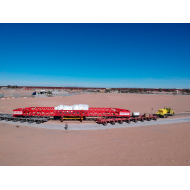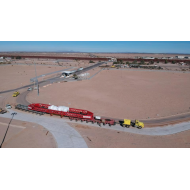Tradelossa, THLG member for Mexico, in collaboration with Barnhart, THLG member for the USA, successfully transported two turbines of similar dimensions for the energy sector from the city of Yuma, located within the state of Arizona, to two different locations: the city of San Luis Rio Colorado and the Delegation of González Ortega, Mexicali, both destinations within the border state of Baja California, Mexico.
The project was challenging and complex because it required two transportation operations and border crossings of two oversized loads weighing over 200 tons each, through two different routes and connecting two nations.
Coordinating with customs authorities from both Mexico and the United States was a key aspect of the success of these operations. The goal was not only to ensure that all components reached their respective destinations in less than 24 hours but also to ensure the integrity of both turbines following only the highest standards of quality and safety established by both companies.
Achieving the crossing from two different spots at the border between Mexico and the US was a task that required operational symbiosis. With both turbines departing from Yuma, Arizona, USA, Turbine #1 was destined for the San Luis Rio Colorado Combined Cycle Power Plant, located in Baja California. This piece followed its route from Yuma all the way down through its border with Mexican lands, connecting directly with the city of San Luis Rio Colorado, B.C.S.
Turbine #2, on the other hand, brought a different challenge to the table, specifically because its destination would be located at the González Ortega Combined Cycle Power Plant, making it necessary for the component to be hauled through the Calexico’s border crossing in California.
Reaching Gonzales Ortega would not be a simple task. An exhaustive route analysis revealed that to ensure the arrival of the piece at the power plant, it would be necessary to adapt and reinforce the structure of a local bridge on the Mexican side of the route. These adaptations had the goal of mitigating the impact of the cargo's weight, reducing the pressure of over 200 tons on the bridge’s structure.
CARGO DIMENSIONS:
Two turbines with identical dimensions measuring 10.67 meters in length, 3.96 meters in width, and 4.57 meters in height.
CARGO WEIGHT:
216 tons per turbine.
LOCATION OF EXECUTION:
Origin: Yuma, Arizona.
Destinations: Turbine #1 at CCC San Luis Rio Colorado and Turbine #2 at CCC González Ortega.
PREPARATION TIME FOR THE PROJECT:
During the planning and preparation time of the project, the engineering and operations team identified that to achieve the optimal transfer of both turbines within such a challenging timeframe, it would be necessary to use equipment with the necessary technological capabilities to adapt to the physical conditions and obstacles within the two routes connecting the two nations.
The response was the cutting-edge girder bridge equipment known as "Faktor 5," originally deployed by Barnhart's operational team in the North American city of Yuma.
On the part of Tradelossa, the movement was carried out with a Prime Mover, a specialized trailer built and adapted for the Mexican engineering department which would provide the necessary starting and pushing force to transport the colossal girder bridge structure and turbines throughout the Mexican side.
Each movement had to be planned; a schedule was made a month in advance, during this timeframe, key points such as the transport schedule, staff assignment, and the request and processing of all permits and documentation necessary for the piece's crossing through the border and entry into the plants would be defined.
Similarly, the use of Tradelossa's staff expertise was required, with two key members acting as supervisors for all transfers, maneuvers and rigging operations carried out in the field throughout the project.
The entire project lasted just over a month, including planning, execution, and unloading of the cargo and site, successfully completing the transfer of both components.
Important Dates:
- SLRC Turbine:
- Load (U.S.): September 12.
- Crossing at border: September 13.
- Unloading at site (Mexico): September 14.
- G.O. Turbine:
- Load (U.S.): September 12.
- Crossing at border: September 13.
- Unloading at site (Mexico): September 14.
THLG MEMBER’ COLLABORATION:
To achieve such a feat on the field, a high level of communication and operational symbiosis with our collaborators on the American side, Barnhart, was vital for the success of the project.
Before the start of the project’ operations, it was necessary not only to strengthen and reinforce all communication channels between each department involved but also to consider different measures and personalized solutions for each possible setback and challenge that could have arisen when transporting each turbine from its point of origin in American territory, crossing the border, and to the two destination Power Plants located within Mexican territory.
For the project planning, different joint works and exercises were carried out, creating specific work schedules for each team and their counterparts, as well as defining routes and assigning dates and operational times in both countries by Tradelossa engineering team, seeking to optimize the use of resources and assets provided by both companies, such as the cutting-edge Girger bridge equipment, Faktor 5, provided by Barnhart, and the specialized Prime Mover equipment provided by Tradelossa to transport both turbines.
The result was that each party fulfilled their commitments, maintaining operational symbiosis and a flow of communication between both teams following the highest standards of quality and service that characterize Barnhart and Tradelossa, thus achieving an ideal execution, respecting all timeframes requested by our clients.


